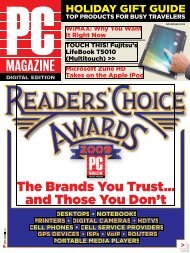PC Magazine - 2009 04.pdf - Libertad Zero - Blog
PC Magazine - 2009 04.pdf - Libertad Zero - Blog
PC Magazine - 2009 04.pdf - Libertad Zero - Blog
You also want an ePaper? Increase the reach of your titles
YUMPU automatically turns print PDFs into web optimized ePapers that Google loves.
ThE FuTurE oF 802.11: SpECS oN ThE DraWINg boarD<br />
Specification type DeScription expecteD publication Date<br />
802.11ac throughput categorized as a “very high throughput” specification, 801.11ac would increase throughput over 802.11n<br />
by a ratio of 2 to 1. its spectrum would be 5 ghz.<br />
802.11ad throughput also a “very high throughput” specification, 802.11ad would increase throughput 10 to 1 over 802.11n. it<br />
would reside on the 60-ghz spectrum.<br />
802.11s mesh networking this specification would allow devices such as cell phones or laptops to serve as mesh points, forming<br />
wireless links with each other.<br />
802.11u Security Known as “interworking with external networks,” this specification would enable secure connections for<br />
Wi-fi devices based on the security protocols of the external network the device is using, whether that<br />
network is cellular, ethernet, uWb, or something else.<br />
802.11z ad hoc networking this “direct link setup” specification allows two Wi-fi devices to securely connect to each other in peer-topeer<br />
mode by using the security credentials of a larger network’s access point.<br />
improving ad hoc connections, at least for<br />
business users. Entirely unrelated to what<br />
the Wi-Fi Alliance is doing for device-todevice<br />
communication, it allows two laptops<br />
that would normally communicate<br />
on a secure network to form an exclusive<br />
P2P connection. This happens only after<br />
they’ve authenticated security credentials<br />
through an AP. It’s a super-secure ad hoc<br />
that requires the right security setup.<br />
Zigbee and Z-Wave: home Control<br />
and More<br />
Another 802 Working Group with growing<br />
impact at home is 802.15. It’s a standard for<br />
wireless personal area networks (WPAN)<br />
using very-low-power radios to send small<br />
amounts of data. Bluetooth is one kind of<br />
WPAN; it’s based on 802.15.1. Some industry<br />
groups have for years been using another<br />
version, 802.15.4, to bring wireless home<br />
automation and control to homes. Coupled<br />
with Wi-Fi, these WPANs can create an<br />
ecosystem that stretches from your laptop<br />
all the way to your light switches.<br />
The ZigBee and Z-Wave standards<br />
are two of the most prominent uses for<br />
802.15.4. An industry alliance with many<br />
partners has formed to push each technology.<br />
Both enable intelligent mesh networking,<br />
so the more devices added to a WPAN<br />
the better. Eventually, every light switch,<br />
thermostat, and motor in your home could<br />
have a chip that lets it communicate, and<br />
you would control them all from a single<br />
interface, whether a remote, an LCD panel<br />
on a wall, or your laptop.<br />
Recently utility companies have taken<br />
notice of these technologies. In fact, several<br />
are integrating ZigBee technology<br />
into meters for electricity, gas, and water.<br />
If meters could talk via ZigBee to a home<br />
router or gateway with Internet access,<br />
customers would gain access to real-time<br />
rate information and utilities could automatically<br />
read meters without sending<br />
someone out in a truck. The potential for<br />
saving money is tremendous. Of the 80 million<br />
meters that need replacing, the ZigBee<br />
Alliance won contracts to be in at least one-<br />
third of them in 2008; the Alliance thinks<br />
that number will grow through <strong>2009</strong>.<br />
ZigBee has a lead with the utility companies,<br />
but Z-Wave (owned by Sigma<br />
Designs) is still in the fight for your home<br />
automation. At CES this year, Z-Wave partners<br />
demonstrated energy management<br />
systems to help both utilities and consumers,<br />
as well as the usual home controls—<br />
picture your ADT monitoring panel<br />
doing much more than just sounding the<br />
alarm. One of the cooler items: lock maker<br />
Schlage is adding Z-Wave remote access to<br />
its wares, so you could someday use your<br />
cell phone to lock all your doors at night.<br />
Or imagine doing that with the same universal<br />
remote you use for your TV.<br />
Will ZigBee and Z-Wave overlap with<br />
Wi-Fi? They do today, but if you have<br />
either 802.15.4 technology, it likely came<br />
as a value-added feature from your broadband<br />
provider, which supplied a residential<br />
gateway/router with WPAN tech built<br />
in. Telcos desperately want to horn in on<br />
that security market, and they know that<br />
ZigBee or Z-Wave can help, giving them<br />
another reason to charge customers extra<br />
per month and letting them up-sell you<br />
on new products for that wireless ecosystem—everything<br />
from water-spill monitors<br />
to window alarms to thermostats.<br />
Both groups think that you’ll soon be able<br />
to walk into Best Buy and get a router from<br />
a name brand that includes both Wi-Fi and<br />
ZigBee or Z-Wave.<br />
802.15.4 may appear soon in your phone,<br />
too, to provide extra telecom services.<br />
Korea and some European countries are<br />
doing this already. And ZigBee is pursuing<br />
a personal health strategy, using devices<br />
like the phone to monitor people’s health<br />
status in a non-invasive way.<br />
DlNa: linking More Devices<br />
Another interesting networking story to<br />
come out of CES this year was the Digital<br />
Living Network Alliance (DLNA), a fiveyear-old<br />
consortium of industry companies<br />
that’s only now getting serious attention.<br />
The interest centered on news of full sup-<br />
2012<br />
2012<br />
September 2010<br />
march 2010<br />
January 2010<br />
port in the upcoming Windows 7 operating<br />
system. This move puts Windows 7 devices<br />
at the heart of an ecosystem of DLNAapproved<br />
consumer electronics.<br />
According to DLNA president Scott<br />
Smyers, a senior VP for early supporter<br />
Sony, DLNA certification is all about<br />
interoperability. DLNA itself is based on<br />
Universal Plug and Play (UPnP), but that<br />
protocol only goes so far when handling<br />
discovery between network nodes and<br />
providing access. DLNA is the layer that<br />
makes sure streaming-media formats can<br />
work across nodes and providing “link<br />
protection” for commercial content using<br />
yet another standard: DTCP-IP, or Digital<br />
Transmission Content Protection over<br />
IP, which will someday prevent copyprotected<br />
digital content on a home network<br />
from going out over the Internet.<br />
DLNA has been tied closely to other<br />
networking standards, such as Wi-Fi and<br />
MoCA (Multimedia over Coax, for networking<br />
across coaxial cable). In fact, if a<br />
networking product aims for DLNA certification,<br />
and it uses wireless 802.11, it must be<br />
certified for interoperability by the Wi-Fi<br />
Alliance before the DLNA will give it a seal<br />
of approval. There are 240 DLNA member<br />
companies, and scores of products at CES<br />
had the logo. To date, the DLNA has certified<br />
4,000 products, including computers,<br />
printers, HDTVs, stereo equipment, DVRs,<br />
and digital picture frames.<br />
Windows 7 may be the catalyst needed<br />
to get DLNA off the ground. Windows 7<br />
users will be able to right-click a media<br />
file and send it instantly to any DLNA<br />
player device on the network. That already<br />
sounds like a step up from finding files<br />
using Windows Media Center.<br />
That said, will DLNA support make it to<br />
all Media Center hardware? The PlayStation<br />
3 is DLNA-ready, like most Sony products,<br />
but Smyers is not sure whether DLNA<br />
is coming to the Xbox 360. That’s a question<br />
for Microsoft. Adding the support via<br />
a software upgrade can only help the Xbox<br />
communicate with Windows 7 computers<br />
of the future, so it seems like a no-brainer.<br />
APRIL <strong>2009</strong> <strong>PC</strong> MAGAZINE DIGITAL EDITION 39







